Abstract
1. The interaction of yohimbine with anxiolytic and putative anxiolytic agents to modify 5-hydroxytryptamine (5-HT) release in the frontal cortex of the freely-moving rat was assessed using the microdialysis technique. 2. The alpha 2-adrenoceptor antagonist, yohimbine (5.0 mg kg-1, i.p.) increased maximally the extracellular levels of 5-HT in the rat frontal cortex by approximately 230% of the basal levels. 3. The alpha 2-adrenoceptor agonist, clonidine (30-100 micrograms kg-1, i.p.) decreased dose-dependently the extracellular levels of 5-HT in the rat frontal cortex by approximately 0-60% of the basal levels. A 5 min pretreatment with clonidine (50 micrograms kg-1, i.p.) prevented the yohimbine-induced increase in the extracellular 5-HT levels. 4. The benzodiazepine receptor agonist, diazepam (2.5 mg kg-1, i.p.) and the 5-HT3 receptor antagonist, ondansetron (100 micrograms kg-1, i.p.) (5 min pretreatment) completely prevented the yohimbine (5.0 mg kg-1, i.p.)-induced increases in the extracellular levels of 5-HT. The 5-HT1A receptor agonist, 8-OH-DPAT (0.32 mg kg-1, s.c.) partially antagonized the yohimbine response. 5. A 5 min pretreatment with the 5-HT3/5-HT4 receptor ligand R(+)-zacopride (10 micrograms kg-1, i.p.) reversed the yohimbine (5.0 mg kg-1, i.p.)-induced increase in the extracellular levels of 5-HT to approximately 30% below the basal levels. A 5 min pretreatment with S(-)-zacopride (100 micrograms kg-1, i.p.) failed to modify the response to yohimbine.(ABSTRACT TRUNCATED AT 250 WORDS)
Full text
PDF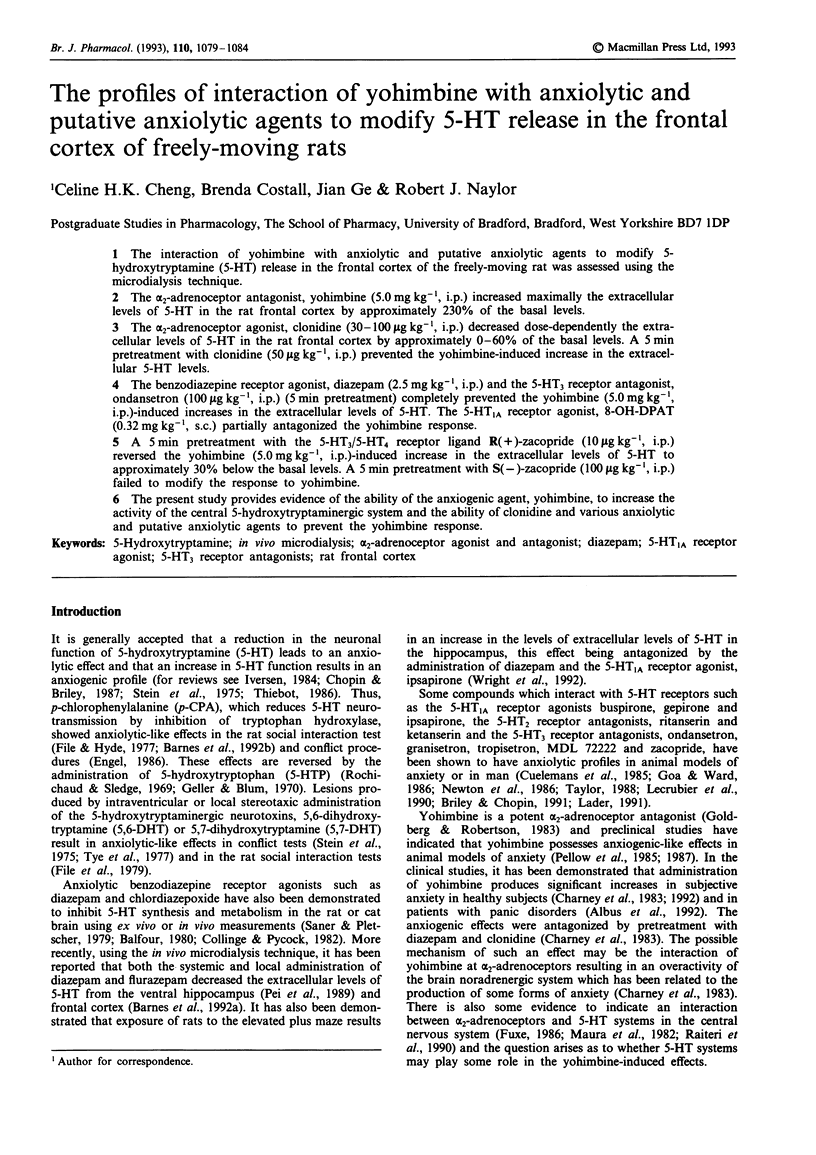
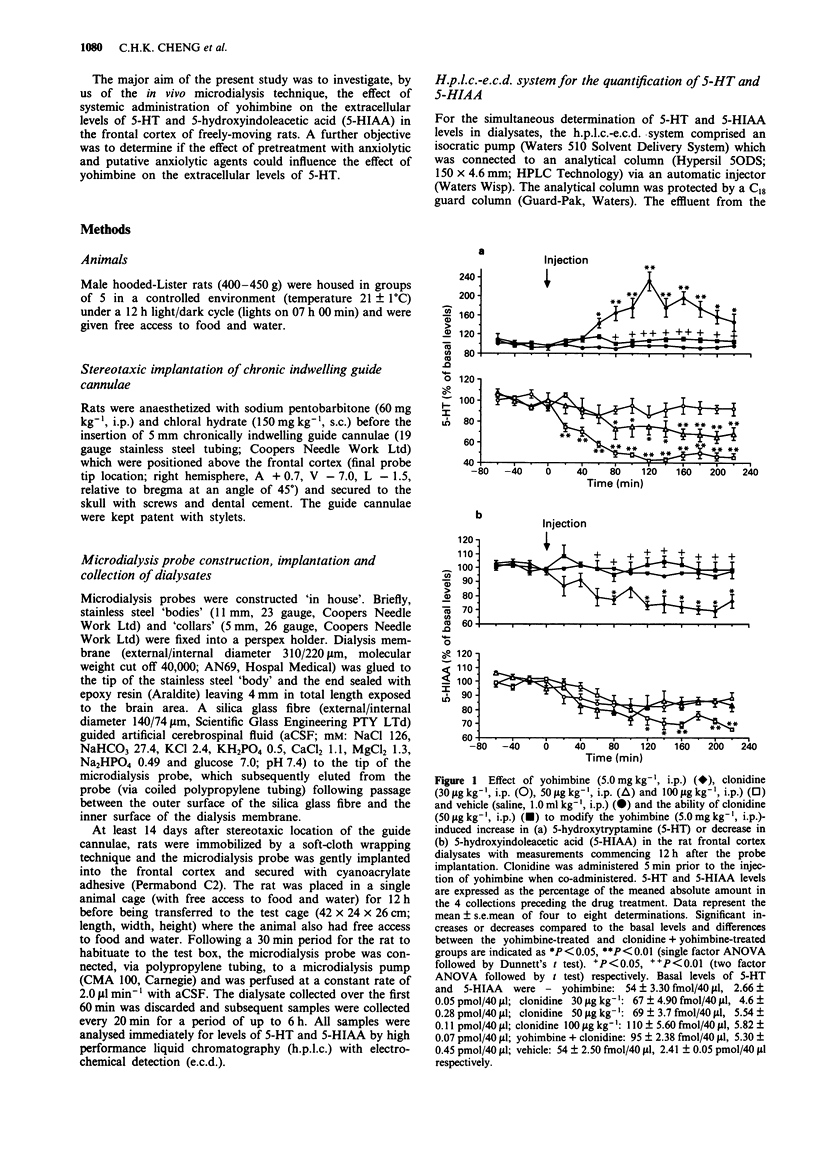
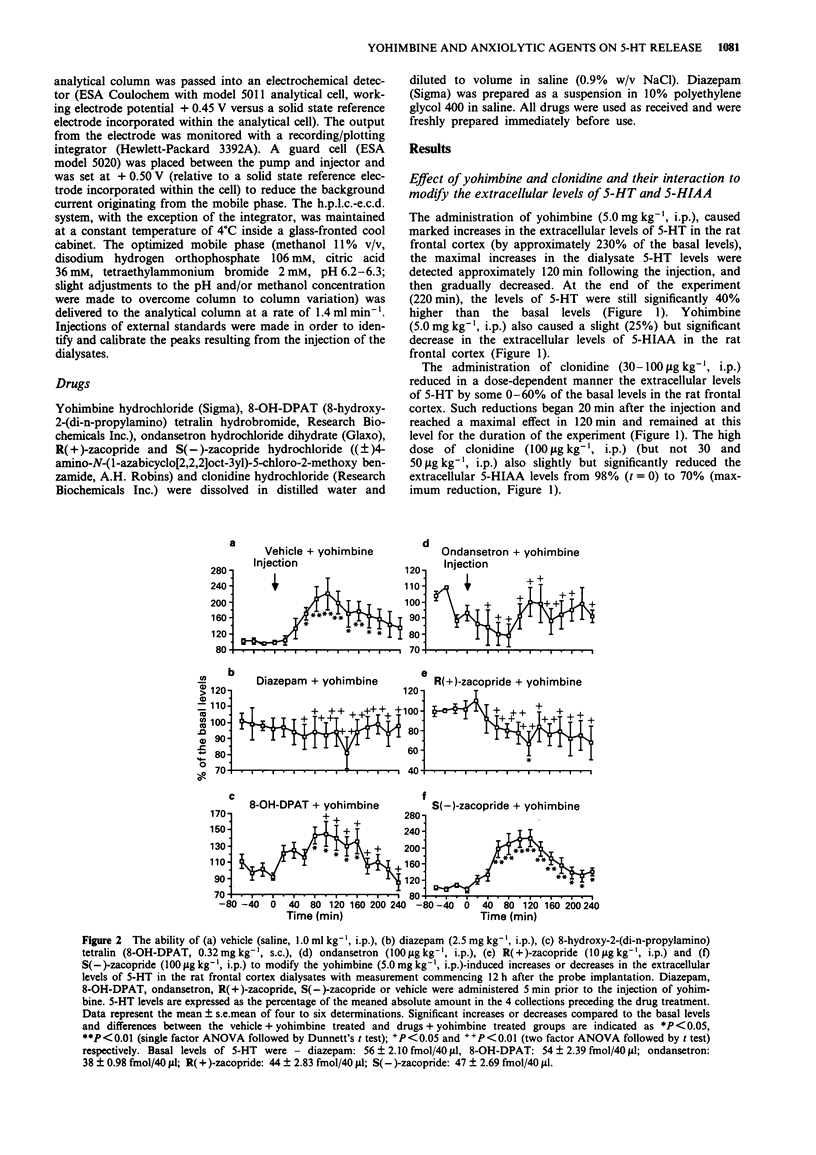
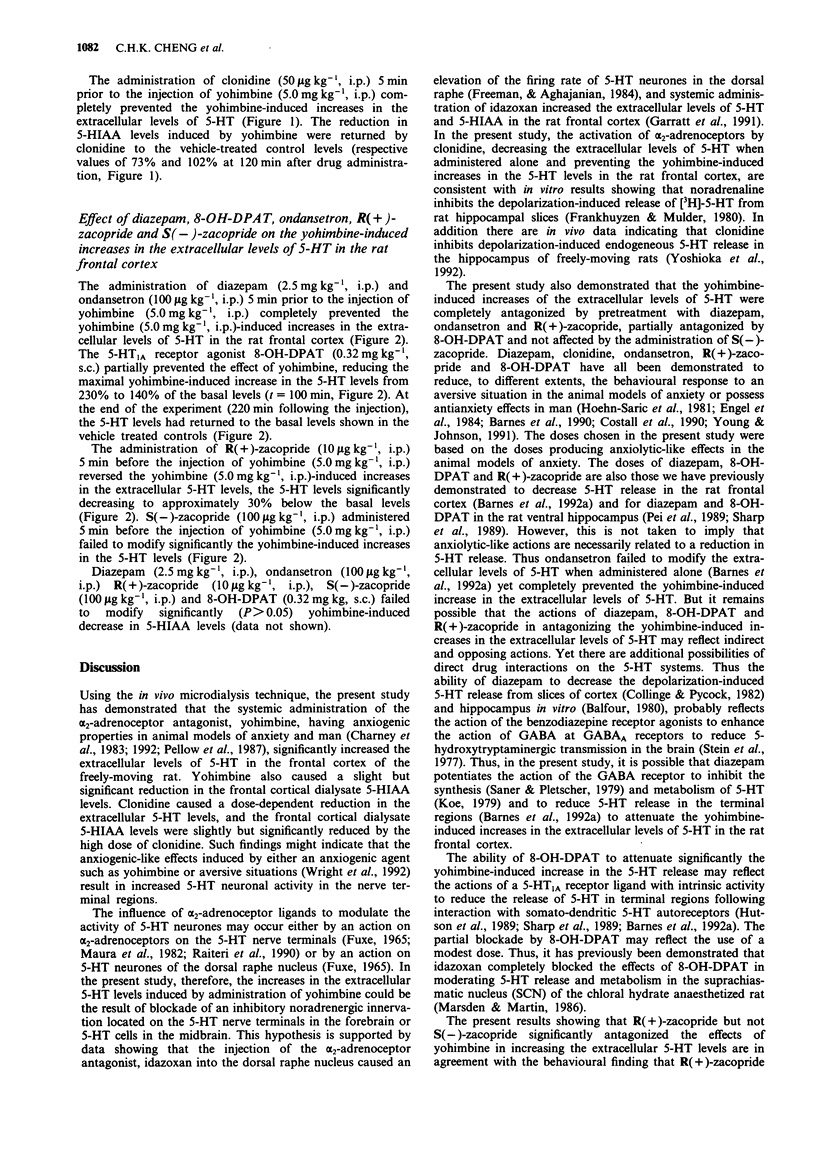
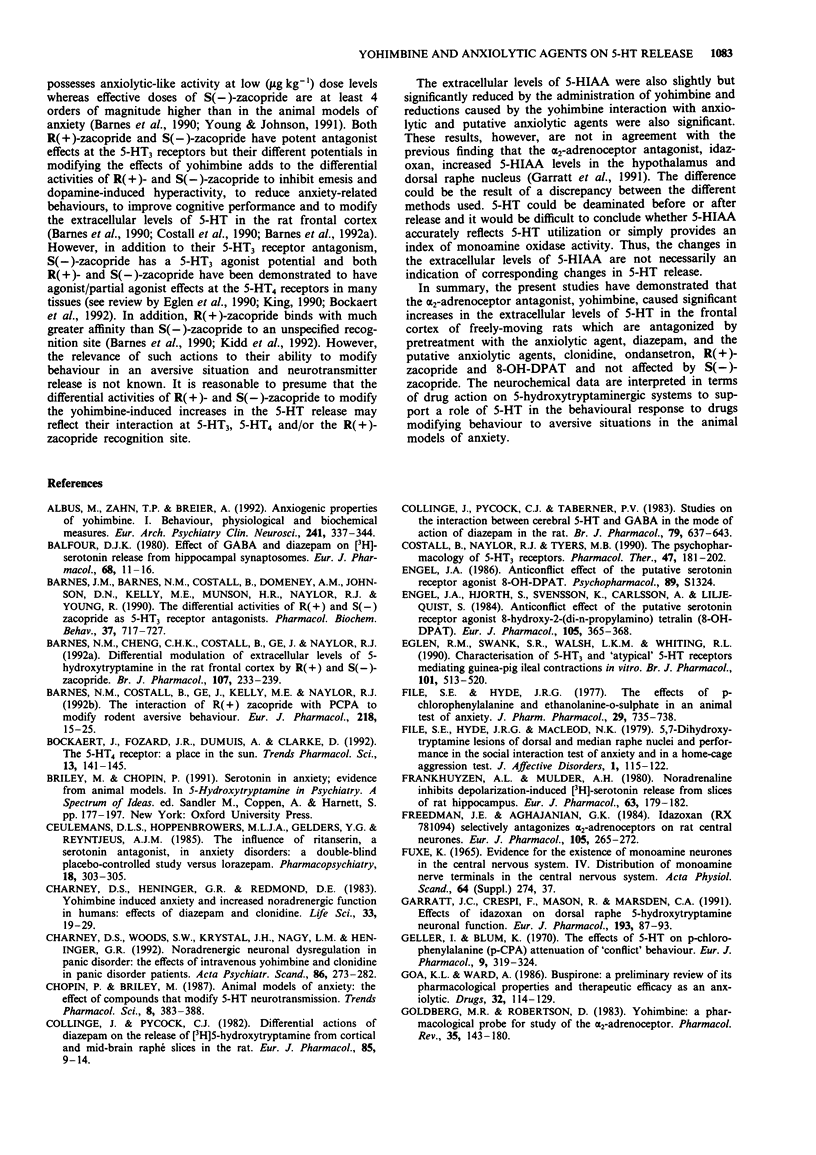
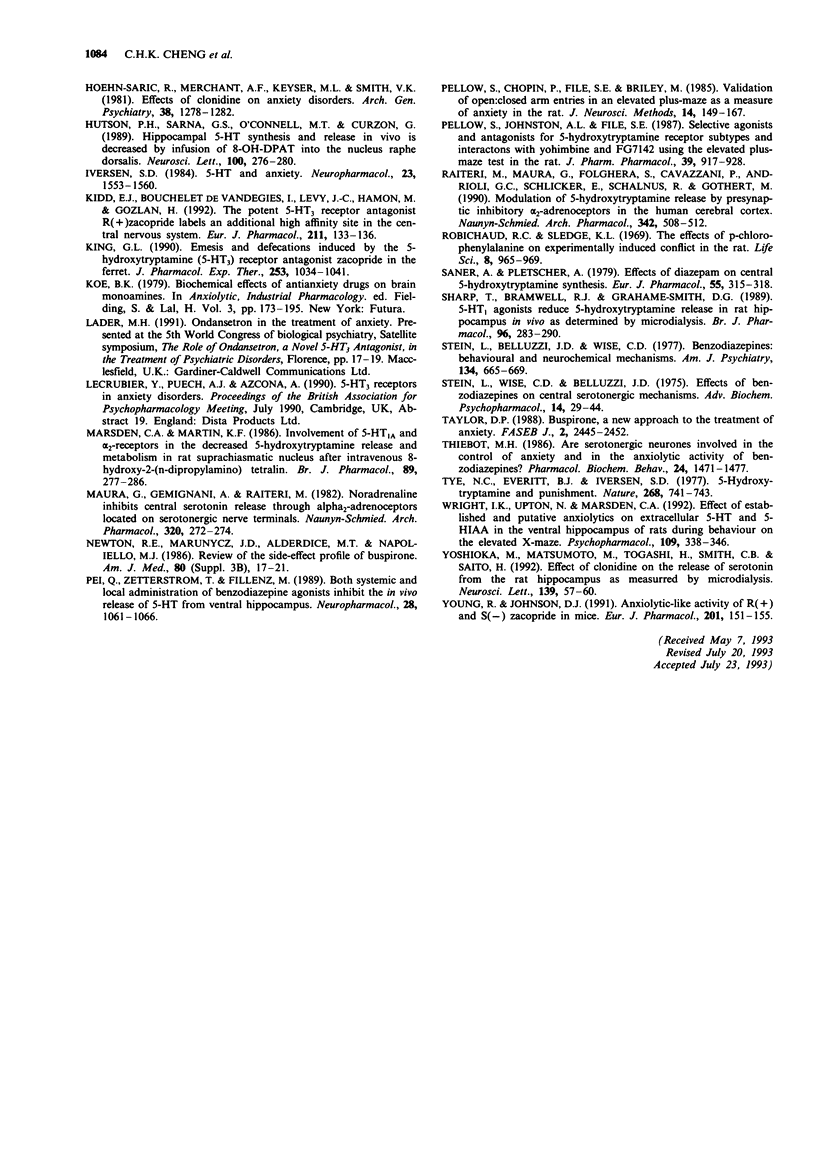
Selected References
These references are in PubMed. This may not be the complete list of references from this article.
- Albus M., Zahn T. P., Breier A. Anxiogenic properties of yohimbine. I. Behavioral, physiological and biochemical measures. Eur Arch Psychiatry Clin Neurosci. 1992;241(6):337–344. doi: 10.1007/BF02191958. [DOI] [PubMed] [Google Scholar]
- Balfour D. J. Effects of GABA and diazepam on 3H-serotonin release from hippocampal synaptosomes. Eur J Pharmacol. 1980 Nov 7;68(1):11–16. doi: 10.1016/0014-2999(80)90054-0. [DOI] [PubMed] [Google Scholar]
- Barnes J. M., Barnes N. M., Costall B., Domeney A. M., Johnson D. N., Kelly M. E., Munson H. R., Naylor R. J., Young R. The differential activities of R (+)- and S(-)-zacopride as 5-HT3 receptor antagonists. Pharmacol Biochem Behav. 1990 Dec;37(4):717–727. doi: 10.1016/0091-3057(90)90554-u. [DOI] [PubMed] [Google Scholar]
- Barnes N. M., Cheng C. H., Costall B., Ge J., Naylor R. J. Differential modulation of extracellular levels of 5-hydroxytryptamine in the rat frontal cortex by (R)- and (S)-zacopride. Br J Pharmacol. 1992 Sep;107(1):233–239. doi: 10.1111/j.1476-5381.1992.tb14492.x. [DOI] [PMC free article] [PubMed] [Google Scholar]
- Barnes N. M., Costall B., Ge J., Kelly M. E., Naylor R. J. The interaction of R(+)- and S(-)-zacopride with PCPA to modify rodent aversive behaviour. Eur J Pharmacol. 1992 Jul 21;218(1):15–25. doi: 10.1016/0014-2999(92)90142-q. [DOI] [PubMed] [Google Scholar]
- Bockaert J., Fozard J. R., Dumuis A., Clarke D. E. The 5-HT4 receptor: a place in the sun. Trends Pharmacol Sci. 1992 Apr;13(4):141–145. doi: 10.1016/0165-6147(92)90051-7. [DOI] [PubMed] [Google Scholar]
- Ceulemans D. L., Hoppenbrouwers M. L., Gelders Y. G., Reyntjens A. J. The influence of ritanserin, a serotonin antagonist, in anxiety disorders: a double-blind placebo-controlled study versus lorazepam. Pharmacopsychiatry. 1985 Sep;18(5):303–305. doi: 10.1055/s-2007-1017385. [DOI] [PubMed] [Google Scholar]
- Charney D. S., Heninger G. R., Redmond D. E., Jr Yohimbine induced anxiety and increased noradrenergic function in humans: effects of diazepam and clonidine. Life Sci. 1983 Jul 4;33(1):19–29. doi: 10.1016/0024-3205(83)90707-5. [DOI] [PubMed] [Google Scholar]
- Charney D. S., Woods S. W., Krystal J. H., Nagy L. M., Heninger G. R. Noradrenergic neuronal dysregulation in panic disorder: the effects of intravenous yohimbine and clonidine in panic disorder patients. Acta Psychiatr Scand. 1992 Oct;86(4):273–282. doi: 10.1111/j.1600-0447.1992.tb03266.x. [DOI] [PubMed] [Google Scholar]
- Collinge J., Pycock C. J., Taberner P. V. Studies on the interaction between cerebral 5-hydroxytryptamine and gamma-aminobutyric acid in the mode of action of diazepam in the rat. Br J Pharmacol. 1983 Jul;79(3):637–643. doi: 10.1111/j.1476-5381.1983.tb10000.x. [DOI] [PMC free article] [PubMed] [Google Scholar]
- Collinge J., Pycock C. Differential actions of diazepam on the release of [3H]5-hydroxytryptamine from cortical and midbrain raphe slices in the rat. Eur J Pharmacol. 1982 Nov 5;85(1):9–14. doi: 10.1016/0014-2999(82)90418-6. [DOI] [PubMed] [Google Scholar]
- Costall B., Naylor R. J., Tyers M. B. The psychopharmacology of 5-HT3 receptors. Pharmacol Ther. 1990;47(2):181–202. doi: 10.1016/0163-7258(90)90086-h. [DOI] [PubMed] [Google Scholar]
- Eglen R. M., Swank S. R., Walsh L. K., Whiting R. L. Characterization of 5-HT3 and 'atypical' 5-HT receptors mediating guinea-pig ileal contractions in vitro. Br J Pharmacol. 1990 Nov;101(3):513–520. doi: 10.1111/j.1476-5381.1990.tb14113.x. [DOI] [PMC free article] [PubMed] [Google Scholar]
- Engel J. A., Hjorth S., Svensson K., Carlsson A., Liljequist S. Anticonflict effect of the putative serotonin receptor agonist 8-hydroxy-2-(di-n-propylamino)tetralin (8-OH-DPAT). Eur J Pharmacol. 1984 Oct 15;105(3-4):365–368. doi: 10.1016/0014-2999(84)90634-4. [DOI] [PubMed] [Google Scholar]
- File S. E., Hyde J. R., MacLeod N. K. 5,7-dihydroxytryptamine lesions of dorsal and median raphé nuclei and performance in the social interaction test of anxiety and in a home-cage aggression test. J Affect Disord. 1979 Jun;1(2):115–122. doi: 10.1016/0165-0327(79)90030-2. [DOI] [PubMed] [Google Scholar]
- File S. E., Hyde J. R. The effects of p-chlorophenylalanine and ethanolamine-O-sulphate in an animal test of anxiety. J Pharm Pharmacol. 1977 Dec;29(12):735–738. doi: 10.1111/j.2042-7158.1977.tb11451.x. [DOI] [PubMed] [Google Scholar]
- Frankhuyzen A. L., Mulder A. H. Noradrenaline inhibits depolarization-induced 3H-serotonin release from slices of rat hippocampus. Eur J Pharmacol. 1980 May 2;63(2-3):179–182. doi: 10.1016/0014-2999(80)90441-0. [DOI] [PubMed] [Google Scholar]
- Freedman J. E., Aghajanian G. K. Idazoxan (RX 781094) selectively antagonizes alpha 2-adrenoceptors on rat central neurons. Eur J Pharmacol. 1984 Oct 15;105(3-4):265–272. doi: 10.1016/0014-2999(84)90618-6. [DOI] [PubMed] [Google Scholar]
- Garratt J. C., Crespi F., Mason R., Marsden C. A. Effects of idazoxan on dorsal raphe 5-hydroxytryptamine neuronal function. Eur J Pharmacol. 1991 Jan 25;193(1):87–93. doi: 10.1016/0014-2999(91)90204-4. [DOI] [PubMed] [Google Scholar]
- Geller I., Blum K. The effects of 5-HTP on para-Chlorophenylalanine (p-CPA) attenuation of "conflict" behavior. Eur J Pharmacol. 1970 Mar;9(3):319–324. doi: 10.1016/0014-2999(70)90229-3. [DOI] [PubMed] [Google Scholar]
- Goa K. L., Ward A. Buspirone. A preliminary review of its pharmacological properties and therapeutic efficacy as an anxiolytic. Drugs. 1986 Aug;32(2):114–129. doi: 10.2165/00003495-198632020-00002. [DOI] [PubMed] [Google Scholar]
- Goldberg M. R., Robertson D. Yohimbine: a pharmacological probe for study of the alpha 2-adrenoreceptor. Pharmacol Rev. 1983 Sep;35(3):143–180. [PubMed] [Google Scholar]
- Hoehn-Saric R., Merchant A. F., Keyser M. L., Smith V. K. Effects of clonidine on anxiety disorders. Arch Gen Psychiatry. 1981 Nov;38(11):1278–1282. doi: 10.1001/archpsyc.1981.01780360094011. [DOI] [PubMed] [Google Scholar]
- Hutson P. H., Sarna G. S., O'Connell M. T., Curzon G. Hippocampal 5-HT synthesis and release in vivo is decreased by infusion of 8-OHDPAT into the nucleus raphe dorsalis. Neurosci Lett. 1989 May 22;100(1-3):276–280. doi: 10.1016/0304-3940(89)90698-8. [DOI] [PubMed] [Google Scholar]
- Iversen S. D. 5-HT and anxiety. Neuropharmacology. 1984 Dec;23(12B):1553–1560. doi: 10.1016/0028-3908(84)90099-6. [DOI] [PubMed] [Google Scholar]
- Kidd E., Bouchelet de Vendegies I., Levy J. C., Hamon M., Gozlan H. The potent 5-HT3 receptor antagonist (R)-zacopride labels an additional high affinity site in the central nervous system. Eur J Pharmacol. 1992 Jan 28;211(1):133–136. doi: 10.1016/0014-2999(92)90276-a. [DOI] [PubMed] [Google Scholar]
- King G. L. Emesis and defecations induced by the 5-hydroxytryptamine (5-HT3) receptor antagonist zacopride in the ferret. J Pharmacol Exp Ther. 1990 Jun;253(3):1034–1041. [PubMed] [Google Scholar]
- Marsden C. A., Martin K. F. Involvement of 5-HT1A- and alpha 2-receptors in the decreased 5-hydroxytryptamine release and metabolism in rat suprachiasmatic nucleus after intravenous 8-hydroxy-2-(n-dipropylamino) tetralin. Br J Pharmacol. 1986 Oct;89(2):277–286. doi: 10.1111/j.1476-5381.1986.tb10257.x. [DOI] [PMC free article] [PubMed] [Google Scholar]
- Maura G., Gemignani A., Raiteri M. Noradrenaline inhibits central serotonin release through alpha 2-adrenoceptors located on serotonergic nerve terminals. Naunyn Schmiedebergs Arch Pharmacol. 1982 Sep;320(3):272–274. doi: 10.1007/BF00510140. [DOI] [PubMed] [Google Scholar]
- Newton R. E., Marunycz J. D., Alderdice M. T., Napoliello M. J. Review of the side-effect profile of buspirone. Am J Med. 1986 Mar 31;80(3B):17–21. doi: 10.1016/0002-9343(86)90327-x. [DOI] [PubMed] [Google Scholar]
- Pei Q., Zetterström T., Fillenz M. Both systemic and local administration of benzodiazepine agonists inhibit the in vivo release of 5-HT from ventral hippocampus. Neuropharmacology. 1989 Oct;28(10):1061–1066. doi: 10.1016/0028-3908(89)90118-4. [DOI] [PubMed] [Google Scholar]
- Pellow S., Chopin P., File S. E., Briley M. Validation of open:closed arm entries in an elevated plus-maze as a measure of anxiety in the rat. J Neurosci Methods. 1985 Aug;14(3):149–167. doi: 10.1016/0165-0270(85)90031-7. [DOI] [PubMed] [Google Scholar]
- Pellow S., Johnston A. L., File S. E. Selective agonists and antagonists for 5-hydroxytryptamine receptor subtypes, and interactions with yohimbine and FG 7142 using the elevated plus-maze test in the rat. J Pharm Pharmacol. 1987 Nov;39(11):917–928. doi: 10.1111/j.2042-7158.1987.tb03129.x. [DOI] [PubMed] [Google Scholar]
- Raiteri M., Maura G., Folghera S., Cavazzani P., Andrioli G. C., Schlicker E., Schalnus R., Göthert M. Modulation of 5-hydroxytryptamine release by presynaptic inhibitory alpha 2-adrenoceptors in the human cerebral cortex. Naunyn Schmiedebergs Arch Pharmacol. 1990 Nov;342(5):508–512. doi: 10.1007/BF00169037. [DOI] [PubMed] [Google Scholar]
- Robichaud R. C., Sledge K. L. The effects of p-chlorophenylalanine on experimentally induced conflict in the rat. Life Sci. 1969 Sep 1;8(17):965–969. doi: 10.1016/0024-3205(69)90427-5. [DOI] [PubMed] [Google Scholar]
- Saner A., Pletscher A. Effect of diazepam on cerebral 5-hydroxytryptamine synthesis. Eur J Pharmacol. 1979 May 1;55(3):315–318. doi: 10.1016/0014-2999(79)90200-0. [DOI] [PubMed] [Google Scholar]
- Sharp T., Bramwell S. R., Grahame-Smith D. G. 5-HT1 agonists reduce 5-hydroxytryptamine release in rat hippocampus in vivo as determined by brain microdialysis. Br J Pharmacol. 1989 Feb;96(2):283–290. doi: 10.1111/j.1476-5381.1989.tb11815.x. [DOI] [PMC free article] [PubMed] [Google Scholar]
- Stein L., Belluzzi J. D., Wise C. D. Benzodiazepines: behavioral and neurochemical mechanisms. Am J Psychiatry. 1977 Jun;134(6):665–669. doi: 10.1176/ajp.134.6.665. [DOI] [PubMed] [Google Scholar]
- Stein L., Wise C. D., Belluzzi J. D. Effects of benzodiazepines on central serotonergic mechanisms. Adv Biochem Psychopharmacol. 1975;(14):29–44. [PubMed] [Google Scholar]
- Taylor D. P. Buspirone, a new approach to the treatment of anxiety. FASEB J. 1988 Jun;2(9):2445–2452. doi: 10.1096/fasebj.2.9.2836252. [DOI] [PubMed] [Google Scholar]
- Thiebot M. H. Are serotonergic neurons involved in the control of anxiety and in the anxiolytic activity of benzodiazepines? Pharmacol Biochem Behav. 1986 May;24(5):1471–1477. doi: 10.1016/0091-3057(86)90214-5. [DOI] [PubMed] [Google Scholar]
- Tye N. C., Everitt B. J., Iversen S. D. 5-Hydroxytryptamine and punishment. Nature. 1977 Aug 25;268(5622):741–743. doi: 10.1038/268741a0. [DOI] [PubMed] [Google Scholar]
- Wright I. K., Upton N., Marsden C. A. Effect of established and putative anxiolytics on extracellular 5-HT and 5-HIAA in the ventral hippocampus of rats during behaviour on the elevated X-maze. Psychopharmacology (Berl) 1992;109(3):338–346. doi: 10.1007/BF02245882. [DOI] [PubMed] [Google Scholar]
- Yoshioka M., Matsumoto M., Togashi H., Smith C. B., Saito H. Effect of clonidine on the release of serotonin from the rat hippocampus as measured by microdialysis. Neurosci Lett. 1992 May 11;139(1):57–60. doi: 10.1016/0304-3940(92)90857-4. [DOI] [PubMed] [Google Scholar]
- Young R., Johnson D. N. Anxiolytic-like activity of R(+)- and S(-)-zacopride in mice. Eur J Pharmacol. 1991 Aug 29;201(2-3):151–155. doi: 10.1016/0014-2999(91)90338-q. [DOI] [PubMed] [Google Scholar]


